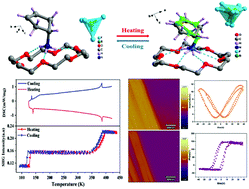Unusual high-temperature host–guest inclusion compound-based ferroelectrics with nonlinear optical switching and large spontaneous polarization behaviours†
Abstract
Host–guest inclusion compounds with multistage reversible phase transitions are ideal materials for constructing molecular ferroelectrics. However, how to accurately design a molecular ferroelectric from a non-ferroelectric phase transition to a ferroelectric phase transition is still a huge challenge. Herein, we have successfully synthesized two high-temperature ferroelectrics [Hcta-(18-crown-6)]+[BF4]− (1) and [Hcta-(18-crown-6)]+[ClO4]− (2) (Hcta = protonated 3-cyclopentene amine). Compounds 1 and 2 crystallize in the ferroelectric space group Pca21. The phase transition mechanism of compound 1 can be attributed to the 2-fold disorder of the Hcta cation and the BF4− anion, resulting in the occurrence of two successive phase transitions to be a two-step NLO switch. Both clathrates exhibit clear ferroelectric phase transitions at about 403 and 394 K, respectively, which are significantly higher than those of BaTiO3 (Tc = 393 K). The spontaneous polarization (Ps ) for 1 and 2 is ca. 5.7 μC cm−2 and 4.7 μC cm−2, respectively.



 Please wait while we load your content...
Please wait while we load your content...